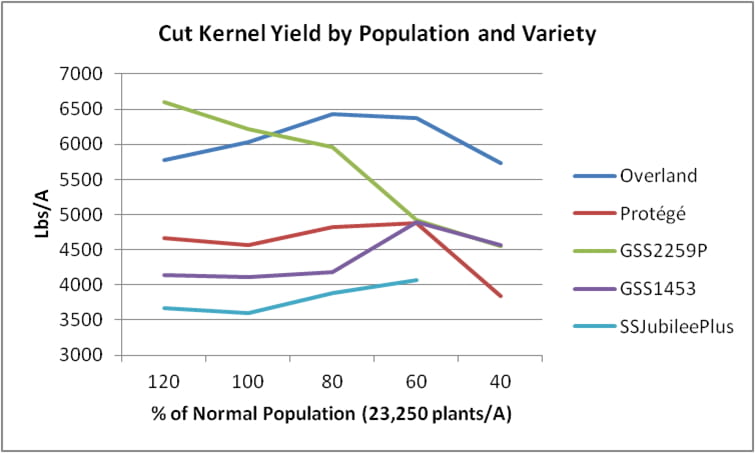Emmalea Ernest, Extension Agent – Vegetable Crops; emmalea@udel.edu
Supersweet sweet corn varieties have desirable quality attributes, but generally have lower seed vigor than sugary enhanced (se) varieties, and the standard recommendation is to wait to plant them until average soil temperatures are above 60-65°F. Nevertheless, supersweet varieties are increasingly being used in early processing sweet corn plantings on Delmarva and reduced stands can sometimes occur when conditions are unfavorable during germination, emergence, and early establishment. In such situations, questions then arise as to whether the planting should be kept or replanted.
For processing sweet corn, unlike fresh market sweet corn, smaller second ears that a plant produces are still usable and contribute to yield. Consequently, processing sweet corn has more potential to compensate for stand loss than fresh market corn, and growers and processors have reported anecdotally that good yields are possible even with substantial stand reduction. In 2012 we conducted two field trials to test the effects of stand loss on processing sweet corn. These trials lend credence to this observation and also give some insight into which varieties compensate well, and how much stand loss can be tolerated.
Five supersweet processing sweet corn varieties were tested in the study: Overland, Protégé, GSS 2259P, GSS 1453, and SS Jubilee Plus. Regional processor fieldmen recommended these five varieties, all of which are being used by processors on Delmarva. The standard planting population for processing sweet corn is 23,250 plants/A. We tested populations of 27,900, 23,250, 18,600, 13,950 and 9,300 plants/A or 120%, 100%, 80%, 60% and 40% of standard population. Two trials were planted with the same treatments; one on April 20, 2012 and one on May 16, 2012. We collected data on yield in terms of ears per acre, weight of unhusked ears per acre (tonnage), and cut corn yield.
Unhusked yield is presented in Figure 1. For most of the varieties there is a gradual decrease in yield from 120% to 60% of standard population and then a steeper drop off in tonnage at the 40% population treatment. GSS2259 is the exception to this trend, as it shows a linear decrease across the range of population densities. For Overland, Protégé and Jubilee, there was not a statistically significant reduction in tonnage until 40% stand reduction.
Figure 1. 2012 Processing Sweet Corn Stand Reduction Study: Unhusked Yield by Population and Variety
Cut corn yield is presented in Figure 2. Yield of Overland peaks at 80% of the standard population, and Protégé, GSS 1453, and SS Jubilee Plus peak at 60% of the standard population. GSS2259P exhibits a very different pattern with a decrease in cut corn yield with decreasing planting population density. For Overland and GSS 1453, there was not a significant difference in cut corn yield across all of the population treatments. Even 40% stand reduction did not result in significant reduction in cut corn yield. SS Jubilee Plus and Protégé did not have significant change in cut corn yield with stand reduction up to 60% of the standard population. GSS2259 had significant reduction in cut corn yield at both 60% and 40% stand reduction.
Figure 2. 2012 Processing Sweet Corn Stand Reduction Study: Cut Kernel Yield by Population and Variety
When taking fields with reduced stands to harvest, one potential problem is uneven maturity caused by uneven population density. In these experiments, all population treatments for each variety were harvested on the same day, which allowed us to detect whether population density is affecting maturity as measured by percent moisture (Fig. 3). The differences in percent moisture across population densities were not significantly different from one another for any of the varieties, and are generally within one percentage point. This would suggest that fields with areas of different levels of stand reduction should not have problematic differences in maturity as a result.
Figure 3. 2012 Processing Sweet Corn Stand Reduction Study: Percent Moisture by Population, Variety and Trial
In conclusion, Overland and GSS 1453 were able to compensate for stand loss in terms of tonnage and, even more so, in terms of cut corn yield—even with population densities that were 40% of standard planting density. Of these two varieties, Overland had higher overall yields in the trials. SS Jubilee Plus also compensated well for reduced stand. Protégé compensated for stand loss up to 60% of standard population density, but produced significantly lower yields in terms of cut corn and tonnage at 40% of standard population density. GSS 2259P did not compensate for stand loss effectively and probably should not be used for early supersweet plantings where risk of stand loss is high. GSS 2259P produced its highest yields in terms of tonnage and cut corn at 120% of the standard population density (27,900 plants/A) which suggests that it should be planted at a higher density to obtain maximum yield.
Reduced stands did not significantly affect time to maturity of the varieties tested, so variable population densities within a field should not present problems for timing of harvest or quality. In our plots with stands reduced to 40% of standard population we did see increased weed growth, a factor which should be considered when deciding whether to keep a field or not.
The 2012 experiments were all with evenly spaced stands. In the coming season we are planning experiments to determine the effects of gaps of different sizes versus even stand reduction. We are hoping that this information will allow us to estimate potential yield loss for processing sweet corn fields with reduced stands.



